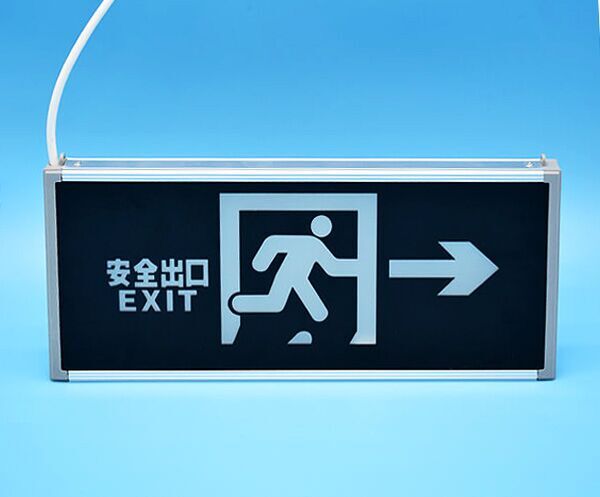Every business wants to know what OSHA standards apply to them because those rules give a good idea of what will keep employees and customers safe. For instance, the rule that every exit route must be clear of obstruction and that the exit door can't have decorations or signs that hide the door is a great guideline for ensuring that your exit is usable in an emergency situation.
As you can imagine, OSHA saves a lot of their rules for how exit areas are illuminated, and you will want to keep abreast of their requirements.
The exit sign has to be illuminated to a certain minimum amount. OSHA requires that the exit sign must be a distinctive color and be illuminated to a surface value of at least five foot-candles. (Foot-candles is an old-fashioned term meaning the illumination produced by a candle at a distance of one foot. It is considered the equivalent of one lumen incident per square foot. In this case, five foot-candles equals 54 lumens.) Self-luminous or electroluminescent signs (lighted signs that you are probably using) should have a minimum brightness of at least .06 footlamberts. Footlamberts are a measurement of brightness that the US uses and is the equivalent of 3.4262591 candelas per square meter (nits).
The entire route to the exit should have enough light that a person of normal vision can see along it. This may mean installing lights along the route or laying out luminescent tape along the hall.

To ensure the effectiveness and reliability of egress lighting, the NFPA’s Life Safety Code has set forth four criteria; performance, operation, power source and testing. These are looked at in the below sections. It is also important to familiarize yourself with any local fire or building codes that may be applicable to your project. Consult your local municipality for information on local fire and building codes and how they apply to emergency lighting and your project.

In the event of power loss, NFPA’s Life Safety Code requires that emergency egress lights provide 90 minutes of illumination. This time is deemed adequate to fully evacuate a large building. Adequate illumination is assured when lights burn at a minimum of 10.8 lux. For testing purposes, a light meter can be placed at floor level and a reading taken.
NFPA’s Life Safety Code requires emergency lighting to operate automatically without receiving a manual reset. If emergency lights are battery operated, they must turn on immediately following the loss of power. If a generator is used for backup power, a buildings emergency power supply system (EPSS) must utilize an automatic transfer switch (aka, “make before break” switch).
Egress lighting may be either powered by batteries or generator, per the NFPA’s Life Safety Code. Batteries for egress lighting must be rechargeable, must recharge to full power in <24 hours, and must meet the requirements set for by the National Electric Code (All our emergency lighting batteries meet the NEC requirements). Backup generators used to power egress lighting must meet NFPA Standard 110 requirements.
NFPA’s Life Safety Code specifies that all egress lighting be tested in two ways. The first is a monthly, 30-second test. Most emergency lighting units, have a manual button for this function, or include a Self Diagnostic Testing module that performs this test automatically every 30 days. The second test is an annual, 90 minute test of backup powered egress lighting. This is a manual test and must be preformed yearly. Power must be cut and all emergency lighting must power on and remain powered for 90 minutes.

OSHA requires exit signs in all commercial, religious, educational, industrial, public housing, medical and any other facilities where the public is allowed or where workers have access to. Private residences are not covered by this requirement and single person offices do not require an exit sign.
OSHA regulations 1910.37(b) cover exit routes and exits and state that an exit route must be lit so a person with normal vision can see along the exit route. Each exit must “be clearly visible and free of any obstructions.” Each exit must be marked by a sign reading “Exit”.
● Exit signs must have the word “Exit” in plainly legible letters not less than 6 inches (15.2 centimeters) high, with the principal strokes of the letters in the word “Exit” no less than ¾ of an inch (1.9 cm) wide.
● Each exit sign must be illuminated to a surface value of at least five foot-candles (54 lux) by a reliable light source and be distinctive in color. Self-luminous or electroluminescent signs that have a minimum luminance surface value of at least .06-foot-lamberts are permitted.
● Each exit route door must be free of decorations or signs that obscure the visibility the exit route door.
● Each doorway or passage along the exit route that could be mistaken for an exit must be marked “Not an Exit” or similar designation, or be identified by a sign indicating it’s actual use (ex. “Closet”).
● If the direction of travel to the exit or exit discharge is not immediately apparent, signs must be posted along the exit access indicating the direction of travel to the nearest exit and exit discharge. Additionally, the line-of-sight to an exit sign must be clearly visible at all times. This can be a sign designating the actual exit discharge (ex. Door to outside safe area) or it can be an exit sign indicating “This way to the exit”.
All our exit signs, both powered signs and self-illuminous exit signs, meet OSHA and NFPA requirements.

 Ni-MH Battery C4700mAh 3.6V
Ni-MH Battery C4700mAh 3.6V Nickel Cadmium Nicd Battery Pack SC1800mAh 3.6V
Nickel Cadmium Nicd Battery Pack SC1800mAh 3.6V Ni-Cd Battery Pack D4000mAh 3.6V
Ni-Cd Battery Pack D4000mAh 3.6V Ni-Cd Battery Pack C2500mAh 3.6V
Ni-Cd Battery Pack C2500mAh 3.6V NICAD Battery Pack AA900mAh 3.6V
NICAD Battery Pack AA900mAh 3.6V LiFePO4 IFR18650 1600mAh 3.2V
LiFePO4 IFR18650 1600mAh 3.2V LiFePO4 IFR18650 1600mAh 6.4V
LiFePO4 IFR18650 1600mAh 6.4V Ni-MH Battery C4000mAh 3.6V
Ni-MH Battery C4000mAh 3.6V E-bike Battery 48V 10Ah JL-1
E-bike Battery 48V 10Ah JL-1 E-bike battery 48V 10Ah Qing Tian
E-bike battery 48V 10Ah Qing Tian